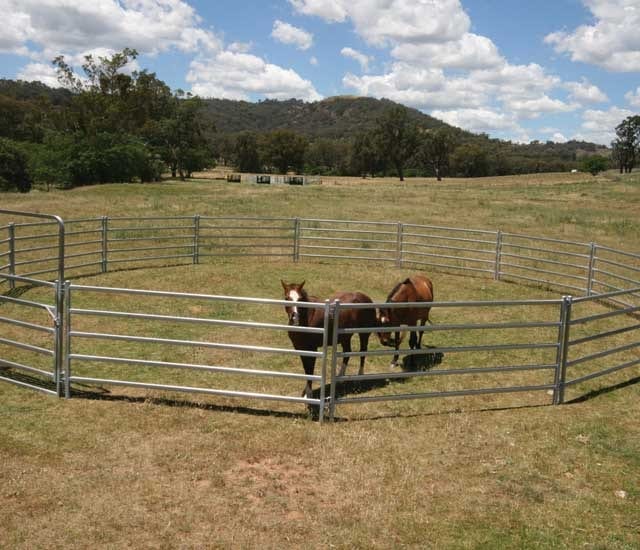Building a Sturdy DIY Cattle Panel Fence: Your Guide to Livestock and Garden Fencing
Are you looking for a durable and cost-effective fence solution for your garden or livestock? Building a DIY cattle panel fence might be the perfect project for you. This guide will walk you through how to build a cattle panel fence, also known as a cattle fence, which is both strong and versatile. Whether you’re aiming to protect your garden, contain livestock like cattle and hogs, or simply enhance your property’s aesthetics, this article has everything you need. Let’s dive in!
What is a Cattle Panel Fence?
A cattle panel fence is constructed using cattle panels, which are heavy-duty, galvanized wire panels designed for fencing livestock. These panels are typically 16 feet long and 50 inches tall, made of welded wire with rectangular openings.
Benefits of a Cattle Panel Fence:
- Durability: Strong enough to withstand pressure from livestock.
- Versatility: Suitable for both garden enclosures and livestock containment.
- Ease of Installation: Ideal for DIY enthusiasts.
- Cost-Effective: Less expensive than traditional fencing materials.
Why Choose a Cattle Panel Garden Fence?
Using a cattle panel garden fence offers numerous advantages for gardeners.
Advantages:
- Support for Plants: Perfect for climbing vegetables like tomatoes and beans.
- Protection: Keeps out unwanted animals from your garden.
- Aesthetics: Provides a clean and rustic look.
- Versatility: Can be used to create arches or trellises.
Materials Needed for Your DIY Fence Build
Before you start your DIY fence project, gather the following materials:
| Materials | Quantity |
|---|---|
| Cattle Panels | Depends on fence length |
| Fence Posts | One per 8 feet of fence |
| Wire Ties or Staples | Enough to secure panels |
| Tools: Hammer, Drill, Wire Cutters | |
| Optional: Concrete | For setting posts firmly |
Note: Ensure all materials are of good quality to build a sturdy fence.
How to Install Fence Posts for Your Cattle Fence
Installing posts correctly is crucial for a strong fence.
Steps to Install Posts:
- Plan Your Fence Line:
- Mark the desired path using stakes and string.
- Measure accurately to determine the number of posts needed.
- Dig Post Holes:
- Space posts approximately 8 feet apart.
- Holes should be at least 2 feet deep.
- Set the Posts:
- Place the post in the hole.
- Use concrete or tamped dirt to secure.
- Ensure the post is level vertically.
- Allow to Set:
- If using concrete, let it cure as per instructions.
Tip: Using pressure-treated wooden posts increases longevity.
Step-by-Step Guide: Build a Cattle Panel Fence
Now, let’s build a cattle panel fence.
Steps:
- Attach Panels to Posts:
- Position the cattle panel against the posts.
- Ensure panels are level and aligned.
- Secure with Wire or Staples:
- Use wire ties or heavy-duty staples to attach the panel to each post.
- Tighten securely to prevent movement.
- Connect Multiple Panels:
- Overlap panels slightly if necessary.
- Use wire ties to connect adjacent panels.
- Add Support Where Needed:
- For added stability, insert additional posts or braces.
Visual Aid:

Using Hog Panels vs. Cattle Panels
Both hog panels and cattle panels are popular in fencing.
Differences:
- Cattle Panels:
- Larger openings (often 6″x8″).
- Ideal for larger livestock like cattle.
- Hog Panels:
- Smaller openings at the bottom, larger at the top.
- Prevent smaller animals from escaping.
Choosing the Right Panel:
- For Gardens: Cattle panels are suitable for supporting climbing plants.
- For Livestock: Choose based on the size of animals.
Securing Your Fence with Wire Ties
Using the right method to secure your fence ensures stability.
Steps:
- Select Quality Wire:
- Use galvanized wire to prevent rusting.
- Tie Panels to Posts:
- Wrap the wire tie around the post and panel.
- Twist tightly using pliers.
- Ensure Even Tension:
- Check that the panel is flush against the post.
- Use multiple ties per post for added strength.
Alternative Fasteners:
- Fence Staples: Ideal for wooden posts.
- Screw-in Fasteners: Provide a more permanent solution.
Incorporating a Gate into Your Fence
Including a gate adds functionality to your cattle panel fence.
Steps:
- Plan Gate Location:
- Choose an accessible spot for entry and exit.
- Construct Gate Frame:
- Use 2x4s to create a frame matching the size of the opening.
- Attach a piece of cattle panel to the frame.
- Install Gate Hardware:
- Attach hinges to one side.
- Add a latch or lock to secure the gate.
Recommendation: For professional gates, consider Farm Fence Gate options.
Tips for a Sturdy and Durable Fence
Ensure your fence stands the test of time with these tips.
Use Quality Materials:
- Opt for galvanized cattle panels to prevent rust.
- Choose pressure-treated posts.
Proper Installation:
- Make sure posts are deep enough.
- Keep panels tight and secure.
Regular Maintenance:
- Check for loose ties or staples.
- Inspect for any damage or wear.
Maintenance and Longevity
A well-built cattle panel fence can last for many years.
Maintenance Tips:
- Regular Inspections: Look for signs of wear or damage.
- Vegetation Control: Keep plants from growing on the fence.
- Repairs: Fix any issues promptly to prevent further damage.
Longevity: With proper care, your fence can last over 20 years.
Conclusion
Building a sturdy DIY cattle panel fence is an achievable project that offers numerous benefits. Whether you’re looking to protect your garden, contain livestock, or simply add a decorative touch to your property, a cattle panel fence is a versatile solution. By following this guide, you can create a durable fence that meets your specific needs.
Key Takeaways
- Cattle panels provide a strong and versatile fencing option.
- Proper installation of posts and panels is crucial.
- Wire ties or staples are essential for securing the fence.
- Incorporating a gate adds convenience.
- Regular maintenance ensures longevity.
For more fencing solutions, explore:
- Galvanised Cattle Panels for high-quality materials.
- Horse Panels for larger livestock needs.
- Heavy Duty Temporary Fence for temporary fencing options.
Ready to start your fencing project? With the right materials and a bit of effort, you can have a reliable cattle panel fence that enhances your property and serves its purpose effectively. Happy building!
Frequently Asked Questions
Q1: Can I use cattle panels for a trellis in my garden?
Yes, cattle panels make excellent trellises for climbing vegetables and plants.
Q2: How tall should my cattle panel fence be to contain livestock?
Most cattle panels are 50 inches tall, which is sufficient for cattle and hogs. For animals that can jump or climb, consider taller fencing options.
Q3: Where can I buy quality cattle panels and fencing materials?
You can find a variety of fencing materials at agricultural supply stores or online at specialized suppliers.




